If you’re looking to improve your ecommerce filters but don’t know how to go about it, we’ve got you covered.
In this article, we’ll walk you through:
- The benefits of improving your ecommerce store’s filters.
- How to improve your ecommerce filters (using 8 different techniques).
By the end of it, you’ll know how to maximize your ecommerce filters’ potential and enjoy the full benefits of these powerful user experience tools.

Optimized ecommerce filters can be the key to getting more sales and conversions in your online store. As an online retailer, you want to create the best shopping experience for your customers to get as many sales and conversions as possible. Ecommerce filters can help you with that.
Improving these filters to make them more helpful to customers can boost your sales and conversions.
Let’s first look at the benefits of improving your ecommerce store’s filters to kick things off.
The benefits of improving your ecommerce store’s filters
When you have tons of products on your ecommerce site, product browsing and selection can be an overwhelming experience for your customers. They’ll have to work hard and spend a lot of time to find a product that fits their taste or preference.
Unfortunately, most customers won’t have this patience. They will likely leave your ecommerce website and potentially go to a competitor where they won’t have the same struggles.
📈 This is backed by research as studies show that 61% of site visitors will leave a website if they don’t find what they’re looking for within 5 seconds.
Ecommerce product filters ensure that this doesn’t happen. They help online shoppers weed out irrelevant products to narrow their search and find their preferred products quickly and easily.
With product filters, shoppers can limit product listings to what they prefer according to things like prices, attributes, for example, color, material, size filters, etc., rating, and so on.
They also shorten the path to purchase, allowing customers to get to the checkout in fewer clicks.
For this reason, ecommerce filter optimization has the following benefits for your ecommerce store.
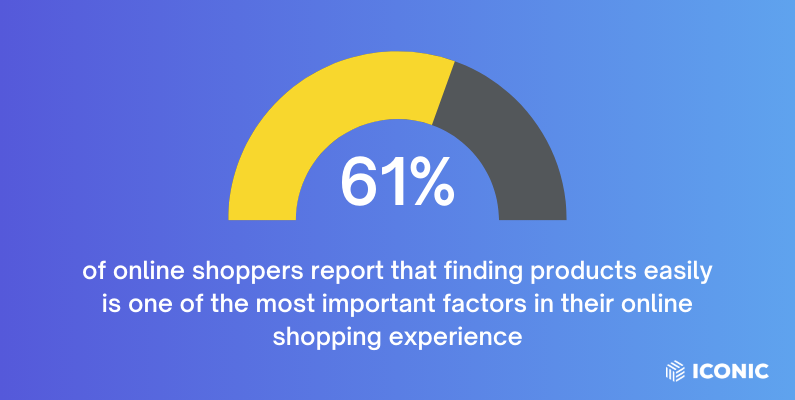
Enhanced user experience
📈 Did you know that 61% of online shoppers report that finding products easily is one of the most important factors in their online shopping experience?
This shows that ecommerce filters can play a crucial role in improving customer experience as they make it easier for customers to find what they’re looking for.
Well-optimized product filters save your customers time as they look through your product catalog for what they might like. Apart from finding a specific product, filters can also help them find related products easily.
Suppose a customer arrives at your ecommerce site looking for a blue hoodie. By selecting the blue color filter, they will be shown other blue apparel, like sweatpants and sneakers, that can go well with the blue hoodie.
The easier it is for customers to find their preferred products, the better their overall shopping experience will be.
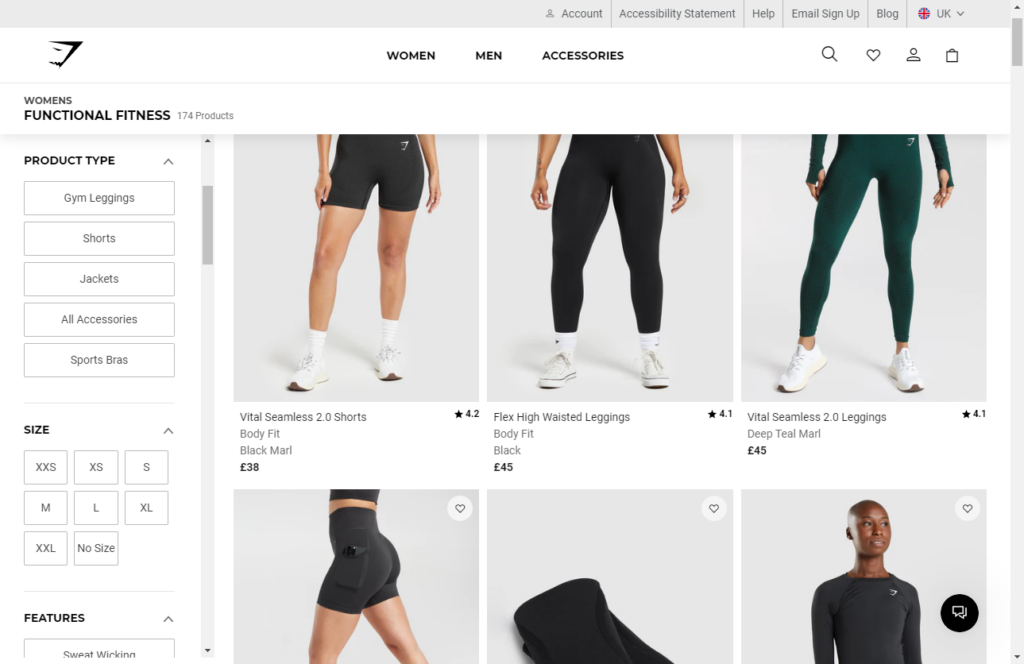
Increased conversion rates
As an ecommerce merchant, you know first-hand how important a great user experience is in driving conversions.
📈 According to Zippia, a better user experience can boost a website’s conversion rate by up to 200%.
This means that improving your product filters generates a better user experience which leads to more conversions. Specifically, a good product filtering system allows customers to get to the checkout in fewer clicks.
This seamless experience helps to get more customers over the line, even those with a low buying intent.
Enhanced market understanding based on applied filters
Product filters can also provide you with useful information on your customers’ preferences when you analyze their usage.
From this, you’ll understand which filters are frequently used or the product attributes that are prioritized. This helps to tailor your product offerings to match their preferences.
In other words, you’ll be able to meet their needs better and improve their overall shopping experience in your ecommerce shop.

Reduced customer support queries
Having well-designed ecommerce filters on your shop, product pages, and category pages can minimize the need for customer support queries. These filters empower shoppers to find their preferred products on their own.
For this purpose, product availability filters are handy. Customers can filter your product listings based on availability (in-stock, out-of-stock, or pre-order). This helps you manage their expectations without requiring them to contact your support team for this information.
The result? A smooth, frustration-free shopping experience.
From the benefits we’ve covered in this section, you can see that improving your ecommerce filters can be very fruitful. However, optimizing your filters to provide a good filtering experience isn’t as easy as it looks.
📈 Website usability tests done by the Baymard Institute revealed that only 16% of websites provide a good filtering experience.
If you’re concerned that your ecommerce site might not be among these websites, we’ve got your back. In the next section, we’ll walk you through several different ways you can improve your ecommerce filters and make them more useful and appealing to your customers.
How to improve your ecommerce filters (in 8 different ways)
If you want to make each of your customers’ clicks count, then improving your ecommerce filters should be a top priority. This includes everything from filter types, filter design, number of filters, etc.
In this section, we’ll walk you through 8 ways to improve ecommerce search and filter features on your online store.
1. Focus on customer experience
The main goal of having product filters in your ecommerce website is to improve your customers’ shopping experience. To fulfill this purpose, your filters must be easy to find and use. This way, customers will be encouraged to utilize them to quickly find what they’re looking for.
There are a few things you can do to ensure that your filters are user-friendly. These include:
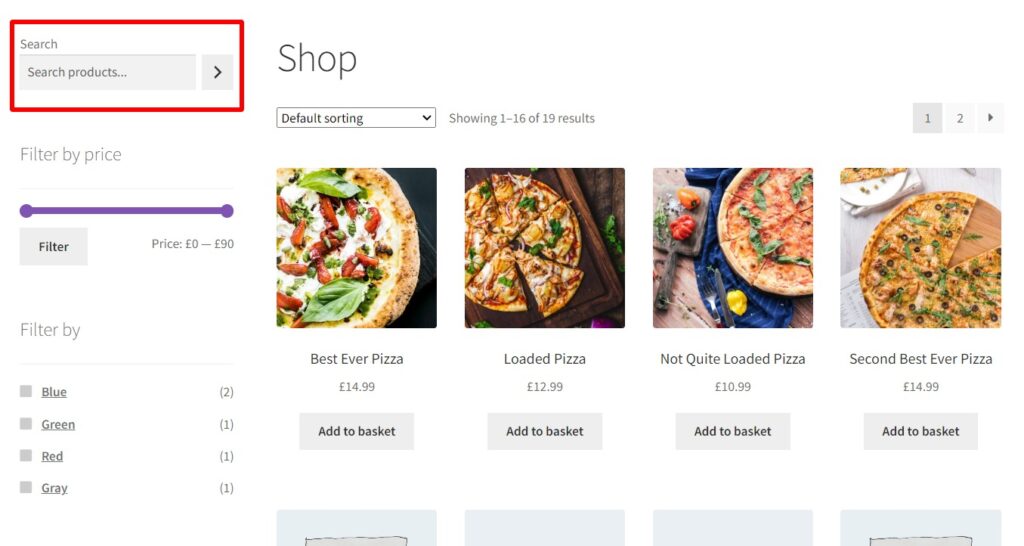
Displaying product filters on the sidebar
The sidebar is an easily accessible area of a webpage. Placing your product filters here ensures that shoppers can quickly find it and use it. It is a standard practice to put this sidebar on the left side and it is where customers expect to find it.
Also, by having filters on the sidebar can simultaneously browse products as they refine their search criteria. This creates an efficient shopping experience and customers will get to see how their selections affect displayed products in real time.
Making use of search filters
Instead of limiting your customers to product filter checkboxes and sliders, you should also include a search bar. This is great for customers who are in a hurry as they will be able to search for the exact product they want.
Note: Ensure not to display zero results – this can push customers to leave your online store immediately. When you don’t have the specific product the customer wants, you can recommend related products or other relevant items based on their search terms.
Keeping it simple, clear, and intuitive
Give your filters a consistent layout and a clean and intuitive design that encourages customers to use them. You can also limit the choices to avoid having a long list of filters cluttering the sidebar and overwhelming your customers with options.
Use simple language when naming the filters to avoid confusing customers. For instance, use terms like ‘Light-weight Denim’ instead of jargon like ‘Chambray’.
By applying these strategies to your product filters, you’ll make them more user-friendly for your customers.
2. Use visual product filters
📈 According to research, nearly 60% of site users strongly prefer visually appealing designs.
This means that relying only on text and dropdowns on your product filters won’t deliver the best experience possible to your customers. We don’t want that.
Luckily, you can improve your product filters by replacing these dropdowns with visual elements like color and image swatches, radio buttons, and so on.
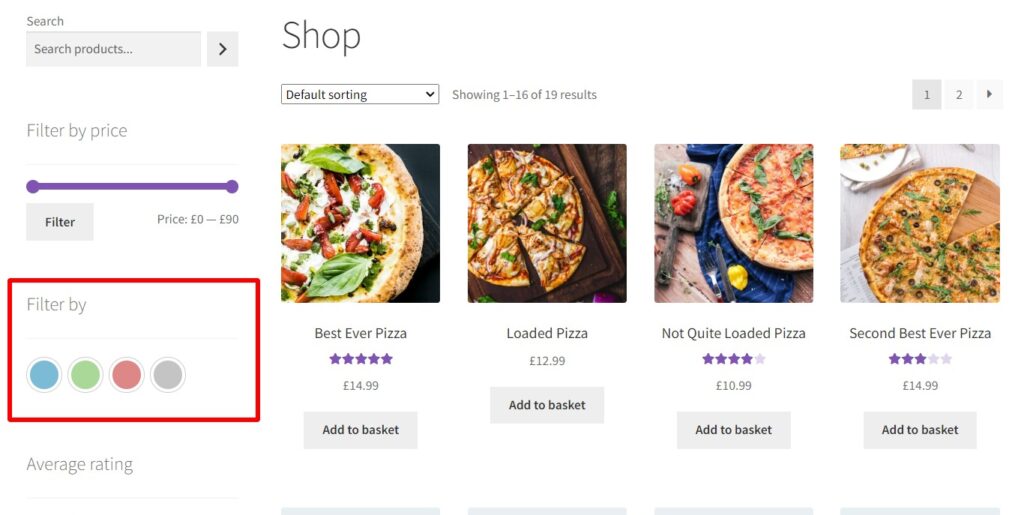
The benefits of visual product filters
These visual elements significantly improve user experience because they are way more engaging than text and dropdowns. They capture your shopper’s attention and retain it throughout their shopping experience.
Visual product filters can also help simplify complex information about your products, especially for products where appearance is key. Let’s say you sell sofas with uncommon colors like beige or amaranth.
With color swatches, customers can see what these colors look like without clicking through each option, one after the other. They get this information quickly and spend less time searching for products and more time purchasing.
The bottom line is that visual product filters make product browsing and selection an enjoyable experience for your shoppers.
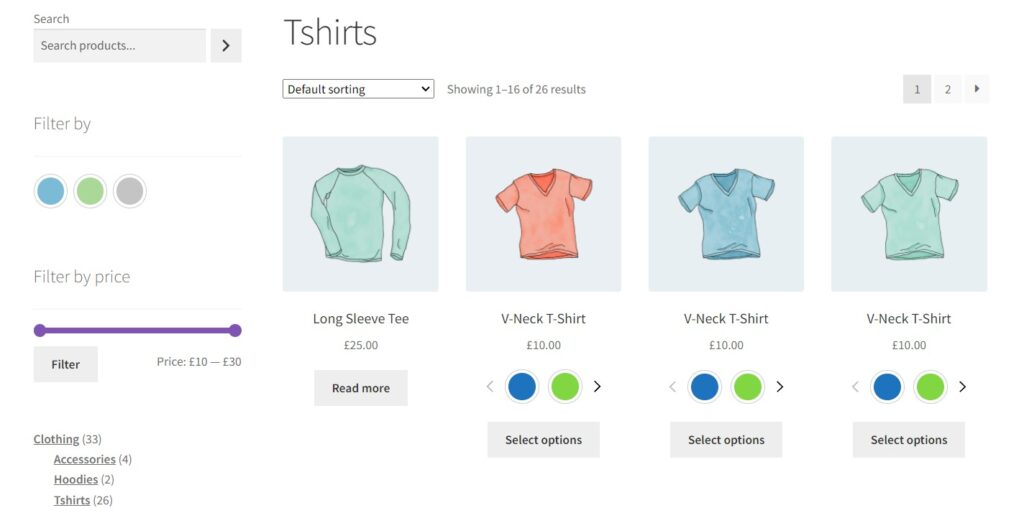
How to add visual product filters to your ecommerce store
If you want to add visual product filters to your WooCommerce sidebar, you will run into a little problem. This is because the default WooCommerce setup lacks this feature.
Fortunately, you can do this and more with the help of the WooCommerce Attribute Swatches plugin.
WooCommerce Attribute Swatches
Turn your WooCommerce product options into color, image, or text swatches. Instantly enhance your customers’ online experience.
Add user-friendly visual product filters using WooCommerce Attribute Swatches
With WooCommerce Attribute Swatches, you can create visually appealing product filters to make product sorting quick and enjoyable for your customers. It allows you to replace the standard WooCommerce product filter dropdowns with color, image, and button-like swatches.
This way, you can move away from unappealing word-heavy default WooCommerce product filters and replace them with something that customers will enjoy using.

Display any color with color swatches
You can use this plugin’s easy-to-use color picker to represent your product’s colors on the sidebar visually. It works great even for rare colors like the ones mentioned above.
Customers will have a visual preview of the colors available before clicking on these options.
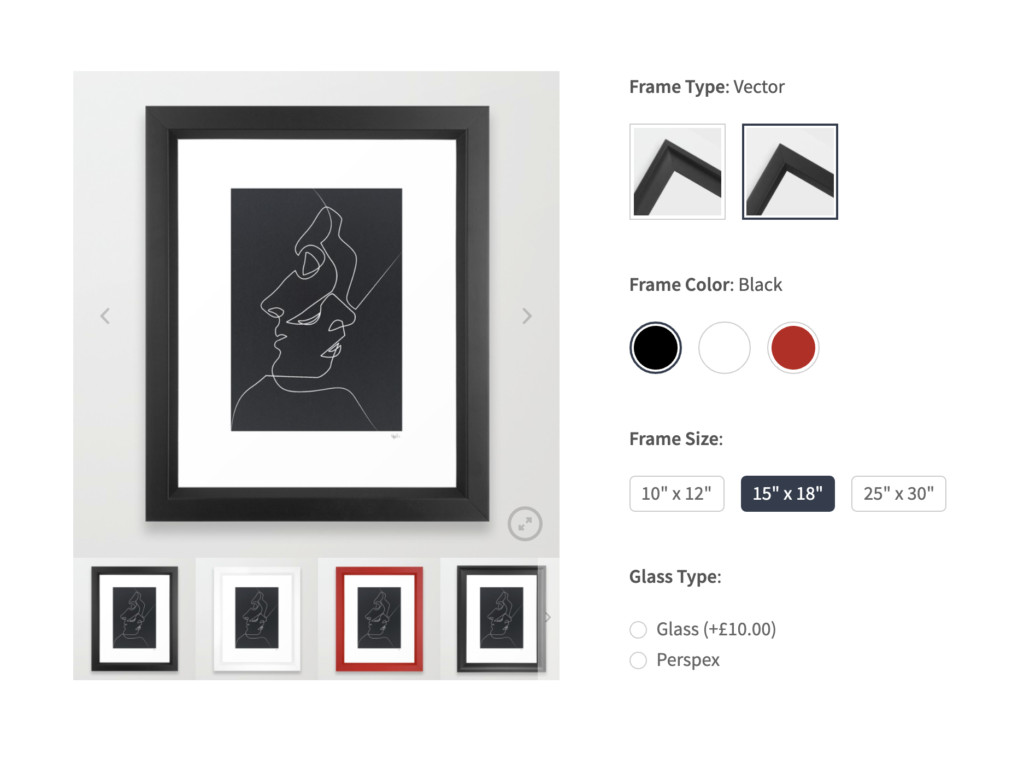
Use image swatches to show a preview of the materials used
Suppose you have products made with different materials, for example, velvet and silk. In that case, you can show your customers a visual preview of these materials using image swatches – thanks to this plugin. You can show them a quick view of what each material actually looks like so that they make a quick decision on whether they’re interested in it.
What about text-based product filters? You won’t have to get rid of them. This plugin allows you to create button-like text-based swatches that are easy to see and click through.

To top it up, WooCommerce Attribute Swatches has a mobile-first design. As a result, customers will still have a great product sorting experience on their mobile devices. This plugin gives you all you’ll need to elevate your customers’ product filtering experience with visual product filters.
WooCommerce Attribute Swatches
Turn your WooCommerce product options into color, image, or text swatches. Instantly enhance your customers’ online experience.
Your product filters can also get you more conversions when you include user ratings or any other form of social proof.
We know ecommerce customers can’t touch or try on products before purchasing them. So, they rely on the information that you provide and what other people have to say about the product they’re interested in.
📈 Trust Pilot reports that 89% of online shoppers search for product reviews before making a purchase.
What’s more interesting is that 84% of them trust online reviews as much as a personal product recommendation.
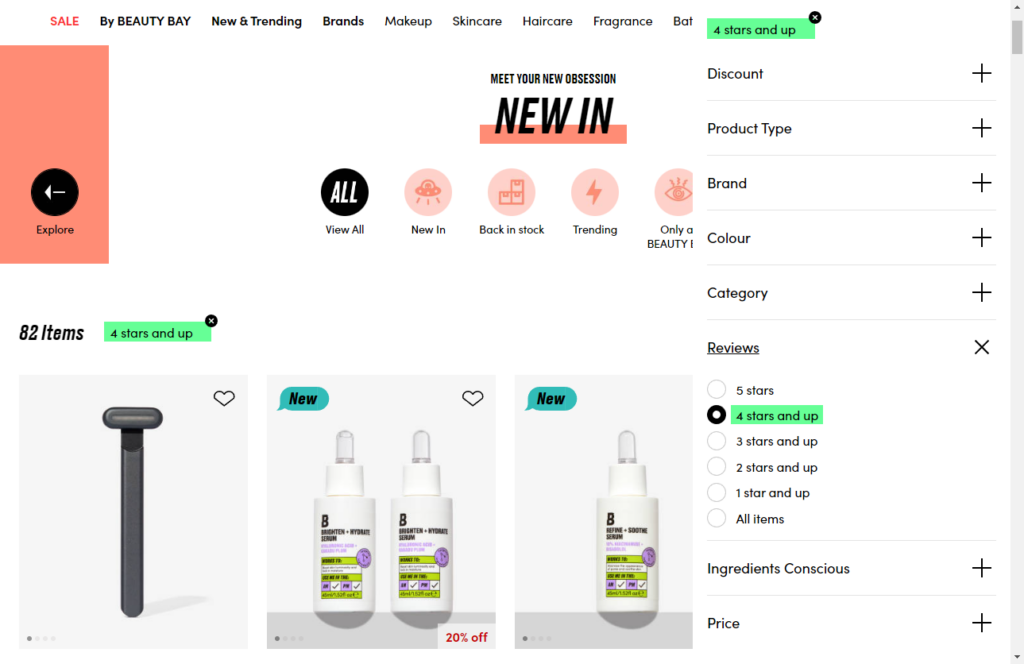
This is why filtering by product rating is a standard practice for major ecommerce sites like Amazon and Macy’s.
Product reviews and ratings help to convince new customers to make a purchase. By including these filters, you’re adding an extra layer of trust. They don’t have to trust you blindly, but they can trust other people who have bought and tried the product.
So, if you want to get more conversions, allow your customers to filter products by user rating or what is most popular among other customers.
4. Use clear distinct category-specific filters
Apart from store-wide filters like price and colors, you should also allow your customers to filter product categories. Category-specific filters help to cater to your customers’ specific preferences.
If you sell apparel, you can include a ‘without fur’ filter for customers allergic to fur. The same applies to other product categories like vegan food, non-stick cookware, etc.
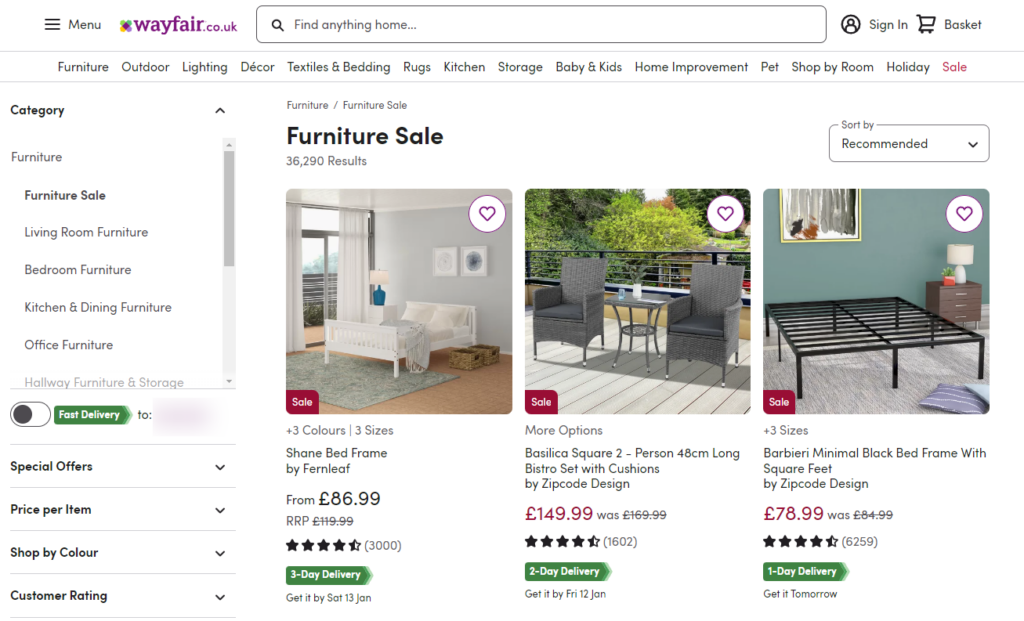
They also help to address product attributes that are difficult to show in the product image, for example, the degree to which a piece of clothing is waterproof.
Organize these filters in clear, distinct categories to make it easy for customers to use them. Use parent categories with collapsable child categories to avoid cluttering the sidebar.
When creating these filters, examine your product descriptions for ideas. But make sure the parameters are significant and you don’t include terms your customers may not be familiar with.
5. Use context-sensitive filter options
You should also consider having dynamic filters that adjust depending on the context of the customer’s search.
For instance, if a customer searches for cold-weather clothing, the filters will change to display something like:
- Material – wool, thermal, or insulated.
- Weather resistance – windproof or water resistant.
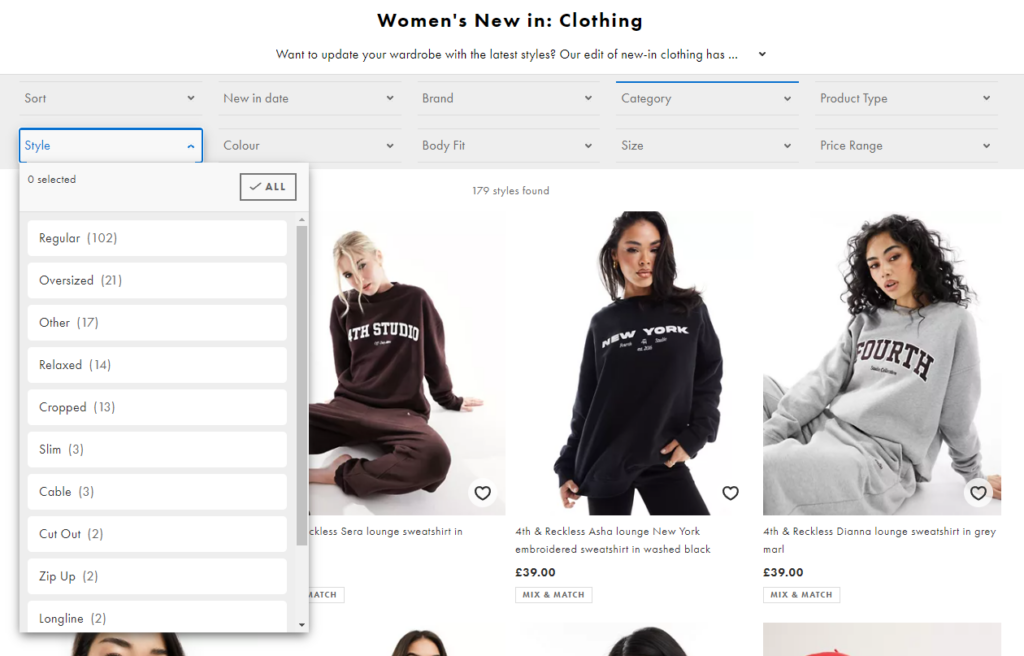
While product filters help display products relevant to the buyer, context-sensitive filters will only display filters relevant to a product category. This will help customers to find what they’re looking for much faster.
In addition, context-sensitive filters present customers with filter options that align with their immediate needs. Because of this, they enable shoppers to discover related products more efficiently.
📈 This could translate to more sales and revenue, as studies show that related product recommendations account for about 31% of ecommerce revenues.
6. Include thematic ecommerce filters and bundles
Customers’ demand for certain products changes seasonally. We understand that managing these trends and meeting customer expectations is crucial in maximizing revenue when these products are in season.
After creating your themed product bundles, you’ll want customers to easily find them. Thematic filters can help you with that.
By including thematic filters, you’ll allow customers to filter products by themes or bundles like ‘back to school’ essentials, ‘beach holiday’ packages, and so on.
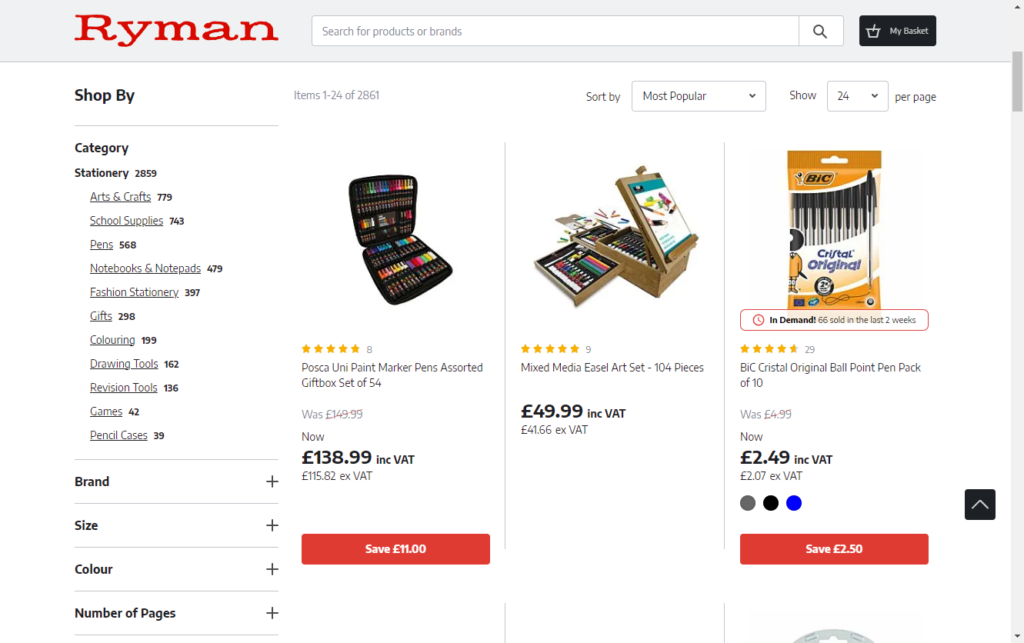
These filters will benefit both you and your customers in the following ways:
- Your customers won’t waste time browsing your website to find these products.
- Your sales and conversions will skyrocket as you’ll be promoting in-season products effectively.
7. Allow customers to filter by delivery option
Another important filter to include in your sidebar is the filter by delivery option. Deliveries are a crucial part of ecommerce as customers want to know how what they want to buy will get to them.
This filter option lets customers know that you offer their preferred delivery option upfront for the products they’re interested in. They won’t have to wait until the checkout to see if their preferred option is available.
This could work in your favor as customers will be more at ease purchasing if you offer their preferred delivery option.
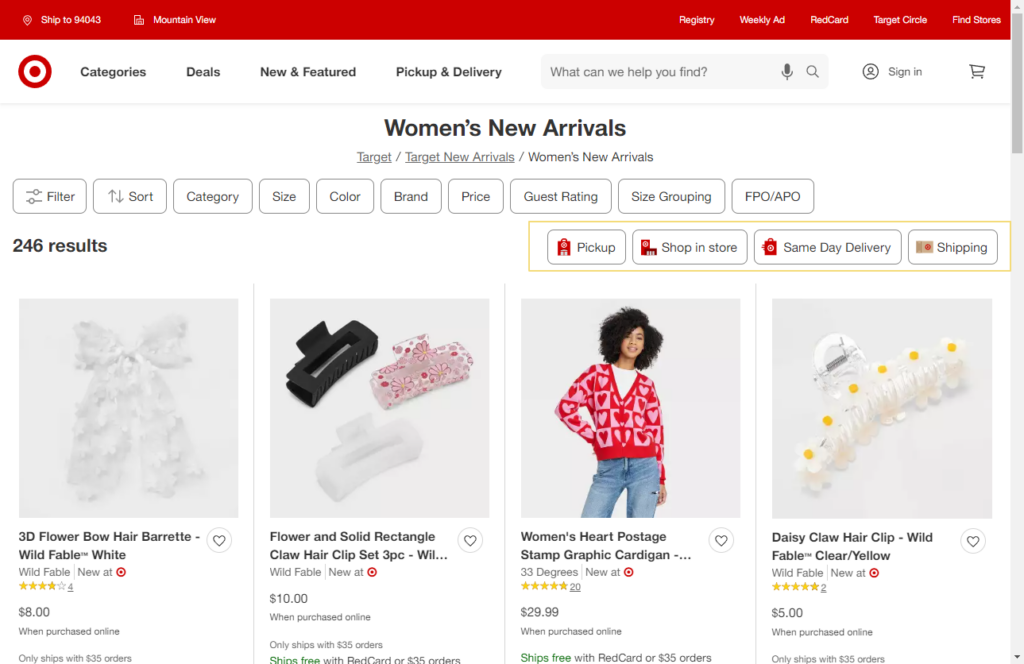
For this filter, ensure to include options such as:
- Same-day delivery – This option can boost your average order value because research shows that 41% of customers are willing to pay additional fees for same-day deliveries.
- Free shipping
- In-store pickup, and so on.
With the ‘filter by delivery option,’ you can avoid customer frustration that results from going through the sales funnel and not finding their preferred delivery option at the end of it.
8. Use gift finder ecommerce filters
Gift-giving is something that most of us struggle with. Unsurprisingly, your customers might not know what exactly to get for whom and when.
📈 This is why studies reveal that up to 32% of people receive at least one unwanted gift each year.
With gift finder product filters, you can take the work of finding the perfect gift, off your customers’ hands.
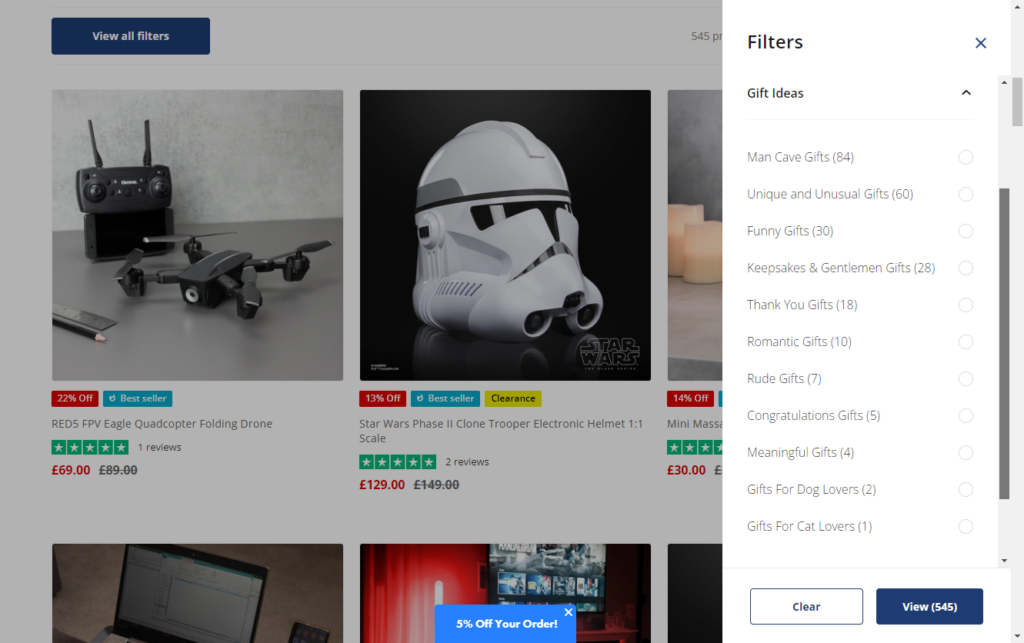
You can implement these special filters to aid your customers when they’re gift shopping. You’ll be able to include gift finder filters like ‘gifts for him/her’, ‘last minute gifts’, ‘gifts under $50’, etc., and make gift shopping a breeze for your customers.
You’re free to get really specific and include filters such as ‘Outdoor Enthusiast’, ‘Foodie’, ‘Fashionista’, and so on. Your customers will appreciate these useful product filters and reward you with conversions, return purchases, and loyalty.
Improve your ecommerce product filters today
Product filters are powerful customer experience tools, and improving them will enable you to enjoy what comes with a great customer experience.
In this article, we’ve looked at 8 different different strategies you can implement to improve your ecommerce filters to get more sales and conversions.
Visual product filters are central to a good filtering experience, and you can add this feature to your ecommerce store with the help of WooCommerce Attribute Swatches.
With this plugin, you’ll be able to give your customers an enjoyable product browsing and selection experience.
WooCommerce Attribute Swatches
Turn your WooCommerce product options into color, image, or text swatches. Instantly enhance your customers’ online experience.
